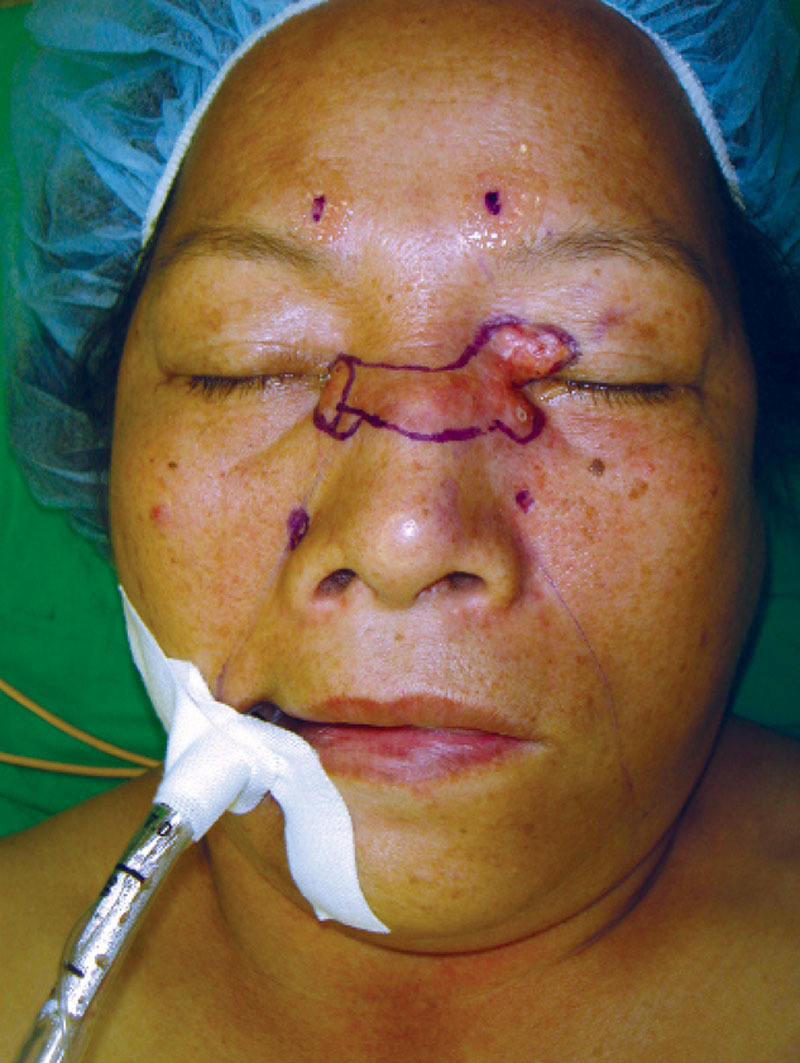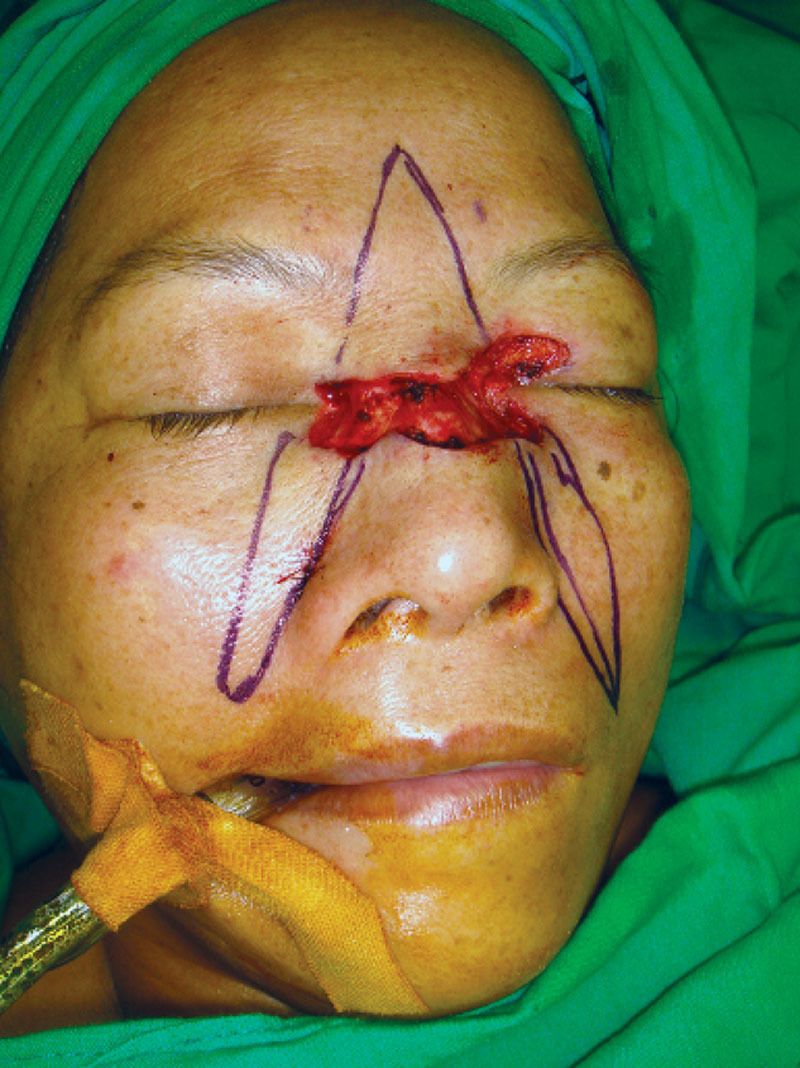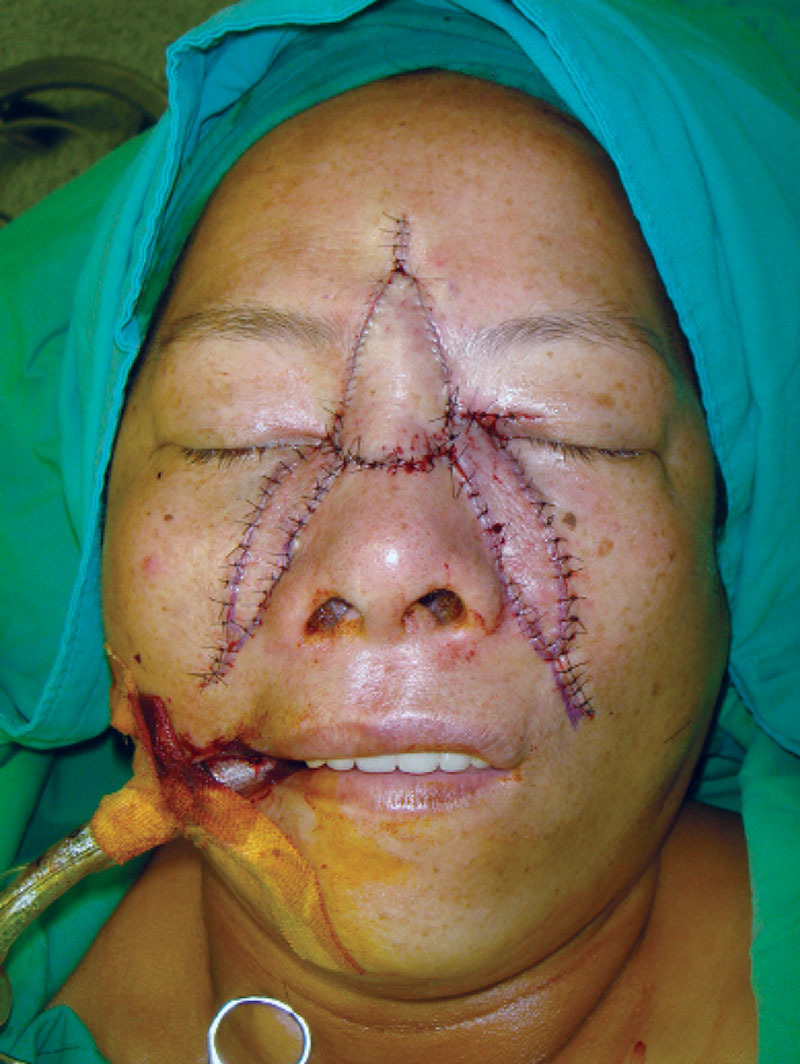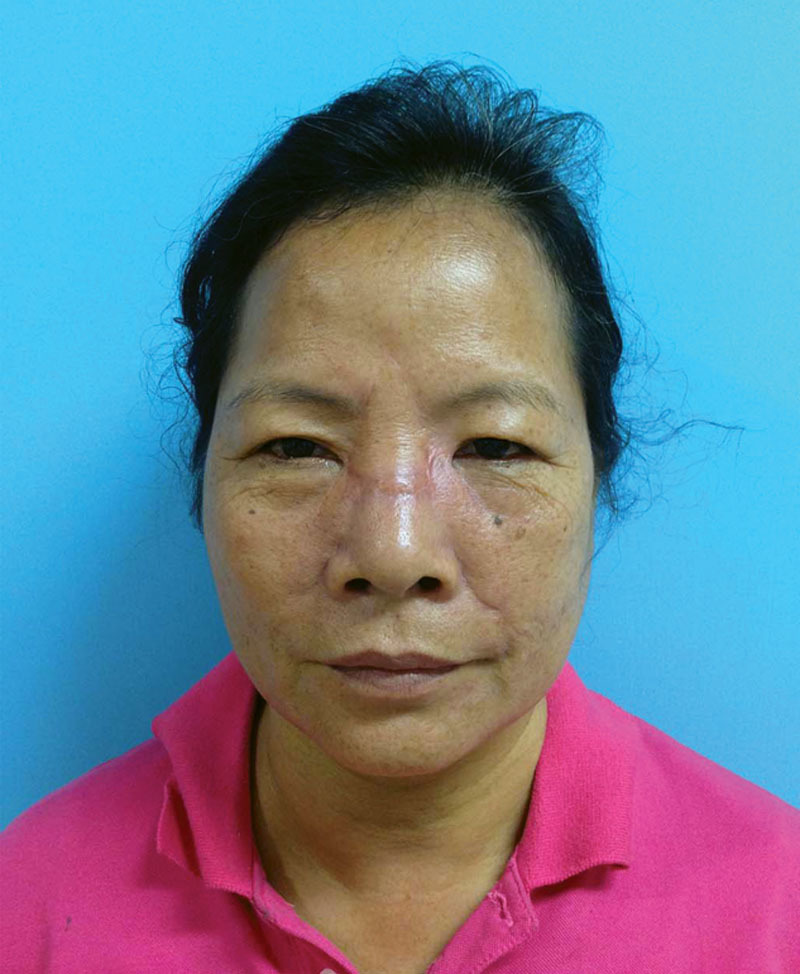Abstract
Summary:
The reconstruction of complex facial soft-tissue defects is a challenge that is often encountered by the plastic surgeon. Careful planning and knowledge of the aesthetic subunits that border the defect are paramount to achieve optimal results. We present a case of a 56-year-old woman who underwent excision of a large disfiguring chronic xanthelasma that extended from canthus to canthus across the nasal bridge. An aesthetic outcome was achieved by use of bilateral V-Y nasolabial flaps combined with a V-Y glabella advancement, which allowed for a tension-free like-for-like subunit reconstruction.
CASE REPORT
A 56-year-old woman presented with a 1-year history of a raised erythematous lesion that extended from canthus to canthus across her nasal bridge (Fig. 1). She had a history of hypercholesterolaemia but was otherwise fit and well. An incision biopsy was arranged which revealed changes consistent with chronic inflammation on a background of xanthelasma. Despite this benign diagnosis, the patient insisted upon surgical excision as she had become extremely conscious of the lesion to the extent that she would avoid leaving the house. After appropriate patient counseling with regard to the possible complications of surgical management, the patient was scheduled for marginal excision and immediate reconstruction. Under general anesthesia, the lesion was excised en bloc and sent to histology. Bilateral nasolabial V-Y island flaps were raised and advanced cephalad and a glabella V-Y island flap was raised and advanced caudal to complete the ‘like-for-like’ subunit reconstruction (Figs. 2, 3). In this case, it was not necessary to skeletonise the perforators of the angular artery that supplied the nasolabial flaps to achieve the desired advancement; however, when required to do so, we never hesitate to skeletonise these perforators. The donor scars were camouflaged within the nasolabial folds and vertical wrinkle lines of the glabella region, no complications were encountered, and an aesthetic result was observed at 12 months follow-up (Fig. 4). Histology confirmed xanthelasma.
Fig. 1.

Chronic xanthelasma marked for marginal excision.
Fig. 2.

Bilateral V-Y nasolabial island and glabella flaps marked.
Fig. 3.

Immediate postoperative result.
Fig. 4.

Result at 12 months follow-up.
DISCUSSION
Many techniques have been described for the reconstruction of facial soft-tissue defects. An early description of the subunit reconstructive concept was in 1965 when Gonzalez-Ulloa et al1 reported on the use of regional aesthetic subunits in the successful reconstruction of nasal and forehead defects. Since this time, many authors have refined and modified various techniques based on the subunit concept in the search for optimal aesthetic results in facial reconstruction. In particular, in 1985, Burget and Menick2 popularized the subunit principle with regard to possibly the most complex aesthetic facial structure of them all, the nose. By dividing the nose into nine specific subunits, they demonstrated that the best cosmetic results were achieved through reconstructive techniques that respected the individuality of these parts. Moreover, in a histological study carried out in Australia in 2010, Rahman et al3 demonstrated that based on pilosebaceous unit density and dermal/epidermal thickness, the best histological match for a given facial defect is likely to come from an adjacent subunit. This is not a new concept, indeed Gillies and Millard4 were well aware of this in the 1950s when they stated that “the next nearest skin is the next best skin.” Indeed, the marriage of old and new concepts often achieves the best results, and with this in mind, we feel that the combination of the aesthetic subunit principle and the perforator concept5 can help in achieving optimal aesthetic outcomes when dealing with facial reconstruction. Moreover, based on the perforasome principle,6 one can safely and confidently skeletonise the perforators of the angular artery when raising a nasolabial flap and thereby facilitate tension-free advancement of the nasolabial tissue. This approach avoids the transfer of tension onto the surrounding aesthetic subunits and prevents any distortion of these parts. Indeed, the disadvantages of many of the classically described local flaps used in facial reconstruction are a limited arch of rotation and the transfer of tension onto adjacent subunits.
CONCLUSIONS
In summary, by respecting the aesthetic subunits of the face along with an awareness of the perforasome concept, a very favorable one-stage aesthetic result was achieved in this case.
PATIENT CONSENT
The patient provided written consent for the use of her image.
Footnotes
Disclosure: The authors have no financial interest to declare in relation to the content of this article. The Article Processing Charge was paid for by the authors.
REFERENCES
- 1.Gonzalez-Ulloa M, Castillo A, Stevens E, et al. Reconstruction of the nose and forehead by means of regional aesthetic units. Br J Plast Surg. 1961;13:305–309. doi: 10.1016/s0007-1226(60)80060-4. [DOI] [PubMed] [Google Scholar]
- 2.Burget GC, Menick FJ. The subunit principle in nasal reconstruction. Plast Reconstr Surg. 1985;76:239–247. doi: 10.1097/00006534-198508000-00010. [DOI] [PubMed] [Google Scholar]
- 3.Rahman M, Jefferson N, Stewart DA, et al. The histology in plastic aesthetic subunits: implications for common nasal reconstructive procedures. Plast Reconstr Aesthet Surg. 2010;63:753–756. doi: 10.1016/j.bjps.2009.02.066. [DOI] [PubMed] [Google Scholar]
- 4.Gillies HD, Millard DR. The Principles and Art of Plastic Surgery. London: Butterworth; 1958. [Google Scholar]
- 5.Blondeel PN, Van Landuyt KH, Monstrey SJ, et al. The ‘‘Gent’’ consensus on perforator flap terminology: preliminary definitions. Plast Reconstr Surg. 2003;112:1378–1383. doi: 10.1097/01.PRS.0000081071.83805.B6. [DOI] [PubMed] [Google Scholar]
- 6.Saint-Cyr M, Wong C, Schaverien M, et al. The perforasome theory: vascular anatomy and clinical implications. Plast Reconstr Surg. 2009;124:1529–1544. doi: 10.1097/PRS.0b013e3181b98a6c. [DOI] [PubMed] [Google Scholar]


